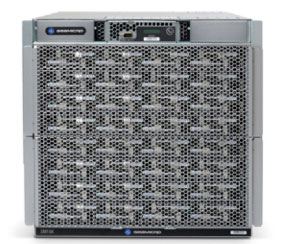SeaMicro server offers self-contained Hadoop microserver solution

With the new certification for CDH4, Cloudera’s Distribution Including Apache Hadoop Version 4, AMD SeaMicro’s SM 15000 Fabric Compute System is attempting to redefine the price, performance, and efficiency model for deploying Hadoop solutions. Their Freedom Supercomputer Fabric provides 1.28 Tb/s of bandwidth supporting up to 512 CPU cores and five petabytes of storage in a single system.
And while ARM processors are seemingly the center of the mainstream microserver market, the SeaMicro 15000, which is the first computing fabric solution certified for the industry leading CDH4 software (which is used by more than 50% of the Fortune 50) runs strictly with x86 architecture processors.
Customers are offered the choice of 64 AMD Opteron processors with up to 64 GB DRAM and eight “Piledriver” cores per CPU, 64 Intel CPUs (“Ivy Bridge” or “Sandy Bridge” microarchitecture) with up to 32 GB DRAM and four cores per CPU, or 256 Intel Atom x86-64 CPUs. This processor selection allows the customer to tune the system for their particular set of price, performance, or efficiency goals.

The fabric storage component of the server supports up to 5 PB of storage, with internal space for 64 drives and up to 1,408 SFF or LFF drives with their external Freedom Fabric Storage arrays. Network connectivity is also flexible with the ability to configure up to sixteen 10 GbE uplinks or sixty-four 1 GbE uplinks. Layer 2 switching is integrated in the system.
With the newly certified systems, AMD SeaMicro is able to deliver a turnkey solution. They are calling it “Hadoop in a box” to customers looking to deploy Hadoop in their enterprise.
With the standardized configurations, AMD can give the customer reliable information on the power consumption and cooling requirements of the hardware while delivering many different levels of performance based on the standardized configuration selected by the customer.